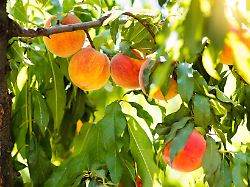The storm in Emilia-Romagna is a devastating blow to Italy’s fruit growers and will also have consequences for German consumers. In southern Italy, farmers are trying to arm themselves against the increasing consequences of climate change with other types of fruit.
The Milan weekly market on Piazza Lagosta is one of the most popular in the city. It’s Saturday morning and as always busy. Long queues can be seen in front of some fruit and vegetable stands. A colorful variety is piled up on the stands. Strawberries used to come first, then cherries, later apricots and finally peaches and nectarines. Everything is available now. That’s what climate change and globalization do.
The prices are at least partly still affordable. This is despite the fact that inflation — which had climbed to 11 percent and is now at 8.2 percent — and soaring energy costs have also hit it hard. For apricots and peaches, it goes from two euros per kilogram upwards. Many could do without cherries this year if the price does not drop from the current six to seven euros per kilo. If you look closely at the price tags, you can see that some of the fruit comes from Spain, Italy’s biggest competitor. The two countries are considered the orchards and vegetable gardens of Europe.
“These are the last of the season’s forerunners,” says Algerian fruit and vegetable stand owner Hussein. “Meanwhile, a lot of fruit comes from Apulia” and points to the apricots, peaches and nectarines. “Unfortunately, I’m afraid there won’t be anything from the Emilia-Romagna region this year. What a tragedy.”
1.5 billion euros in damage in the Fruit Valley alone
Emilia-Romagna is the second largest fruit and vegetable growing region after southern Italy’s Apulia. And it is precisely the region of Romagna, which has been hit twice by devastating storms in less than 14 days, that is also known as the Fruit Valley.
“The damage caused could extend over several years,” explains Marco Salvi ntv.de. He owns several large orchards in the area himself and is also President of the FruitImprese industry association. It will be at least a few more weeks before the full extent of the damage can be quantified. The National Association of Direct Farmers Coldiretti writes in a report that it could be well over 1.5 billion euros.
It is estimated that 80,000 hectares of fruit and vegetable growing areas could have been devastated. “Whereas the pome fruit may have suffered the most damage. Water is particularly deadly for the roots of these trees because they suffocate and die,” adds Salvi. And if nothing can be saved, 15 million trees would have to be replanted. It would take four to five years for these to bear fruit again.
The damage to farmers is enormous. The government has now provided 170 million euros as first aid, which of course is just a drop in the bucket. Added to this is the damage to Italy’s fruit and vegetable production as a whole. The disaster not only affects the domestic market, but also exports. “Italy exported fruit and vegetables worth 5.3 billion euros in 2022,” Salvi points out. Without the production of Emilia-Romagna, an important part is lost.
Germany is Italy’s most important fruit customer
In terms of exports, Germany is Italy’s main buyer of fresh vegetables and fruit. According to Coldiretti, 25 percent of the total export volume in these two sectors goes to Germany. If the fears are confirmed, German consumers will also find fewer peaches, nectarines and other fresh fruit from Italy on the markets and in shops for several years to come.
Emilia-Romagna is currently the focus of aid, but the fruit industry nationwide has been suffering from climate change for years. More and more cultivation areas are therefore being laid fallow. According to a study published by Coldiretti in January, nationally, over the past 15 years, there has been a 43 percent decline in nectarine, table grape vines, 43 percent, pears, 34 percent, apricots, 20 percent, and tangerines 16 percent for oranges. Only the kiwis, which are mainly produced in Lazio and Emilia-Romagna, recorded an 11 percent growth.
The olive trees are also suffering more and more
It’s not just fruit production that’s suffering, things aren’t looking any better for other typical Italian agricultural products either. The deadly Xylella bacterium has led to the deforestation of millions of olive trees, especially in the Salento region of Puglia. The long periods of drought also cause problems for these Mediterranean trees.
According to a study by the market research institute ISMEA, Italy’s 2022/2023 olive harvest is 208,000 tons. That is 37 percent less than in 2021/2022. The situation is not yet as tense as in Spain, where only 1.4 million tons are expected, which means a minus of 30 percent, but still. Only Greece seems to be doing better at the moment. If the estimated production volume of 300,000 tons is confirmed, it would be higher than the Italian one.
Italian farmers fear that the resulting market niches will be filled by other European competitors, and perhaps also by third countries. Also, prices will go up. And this at a time when inflation has already weakened people’s purchasing power.
Late frost, drought, storms, all of this poses enormous challenges for farmers. Those who can, try to arm themselves. “Farmers in Emilia-Romagna have already laid nets over the orchards to protect against heavy hail and some have already set up heating systems to protect against the late frost,” says Salvi. “But nobody was prepared for the tree roots under water,” says Salvi.
At the moment there is a lot of discussion about water storage tanks against the drought, but one or the other farmer is also thinking about growing more resistant crops. Bananas, avocados, mangoes, passion fruit and goji berries are already being grown in Puglia, Calabria and Sicily. In total, they cover an area of 1200 hectares. Who knows, maybe fewer peaches will come soon, but bananas from Italy.
